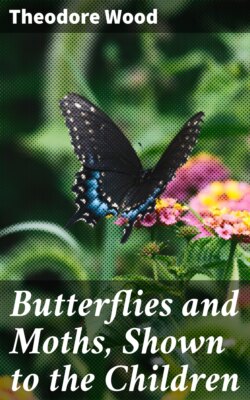Читать книгу Butterflies and Moths, Shown to the Children - Theodore Wood - Страница 6
На сайте Литреса книга снята с продажи.
ОглавлениеPLATE II
1. Small Tortoise-shell
2. Large Tortoise-shell
PLATE II
THE SMALL TORTOISE-SHELL (1)
Table of Contents
This is one of the very commonest of all our British butterflies, and you may see it in almost any month of the year, for it first of all appears early in July, and remains on the wing till about the middle of October. Then it seeks some retired nook, and falls fast asleep until April or the beginning of May, when it leaves its retreat and returns to active life for four or five weeks more. And even in the middle of winter a warmer day than usual will often wake it up for an hour or two from its long slumber, and you may see it flying about, and evidently enjoying the sunshine.
If you want to find the caterpillars of this pretty butterfly, you must look for them on nettle leaves, where you may often see them feeding together in batches of seventy or eighty. They are grey in colour, with a black line running along the back and brown and yellow stripes along the sides, and are covered all over with short, stiff, bristly hairs. When they have reached their full size they wander away from their food-plants, hang themselves up with their heads downwards from a twig, or the side of a wall or a paling, and turn into spiky brown chrysalids, which are covered almost all over with shining golden spots.
PLATE II
THE LARGE TORTOISE-SHELL (2)
Table of Contents
As a rule, you can easily tell this butterfly from the last by its size, for it is generally nearly half as big again. But just now and then a Large Tortoise-shell is no bigger than a “small tortoise-shell,” and then it is not always easy to distinguish the one from the other. So remember that a Large Tortoise-shell never has any white spots upon its wings at all, while the “small tortoise-shell” always has two, one of which is placed close to the tip of each of the front pair.
Large Tortoise-shells are not nearly so common as small ones, but in some years they are much more plentiful than in others. They appear in July or August, sleep all through the winter, and then fly about again during April and May. The caterpillars generally feed upon the leaves of elms, though they will also eat those of willow and apple and pear trees. They are brown in colour, with a broad black stripe along each side, and are covered with thorny black bristles. About the middle of June they turn into flesh-coloured chrysalids, marked with a number of bright golden spots, which you may sometimes find hanging by their tails on tree-trunks and park palings.
